Welcome to todays post all about the classic Disney villains that we all secretly love, or is it love to hate?
Walt Disney once said, “I love Mickey Mouse more than any woman I have ever known.” While the beloved Mickey Mouse has held a special place in the hearts of millions, it is the villains that often steal the spotlight, leaving an indelible mark on the tapestry of Disney’s storytelling.

In this exploration of Disney’s rich history, we delve into the darker corners of the enchanted worlds, where memorable villains lurk, challenging heroes and capturing the imaginations of audiences across generations.
Disney’s Rich History of Creating Memorable Villains
From the ominous forests of the Queen’s castle in “Snow White and the Seven Dwarfs” to the depths of the ocean ruled by Ursula in “The Little Mermaid,” Disney has mastered the art of creating villains who are as captivating as they are sinister.
These characters are not merely obstacles for our beloved protagonists; they are complex figures with motives, personalities, and designs that make them iconic symbols of Disney’s storytelling prowess.
Importance of Villains in Storytelling and Their Impact on the Audience
Villains play a crucial role in the narrative structure, serving as catalysts for conflict and contributing to the development of protagonists. Their malevolence challenges the heroes, forcing them to overcome adversity and grow.
Beyond their narrative function, villains tap into the audience’s deepest fears and desires, making them characters with whom we both love to hate and, at times, empathize. This emotional connection enhances the overall storytelling experience, leaving a lasting impact on viewers.
The Upcoming List of the 10 Classic Disney Villains
As we embark on this journey through Disney’s villainous landscape, prepare to revisit the realms of magic, fantasy, and darkness.
The following list unveils the 10 classic Disney villains, characters whose nefarious deeds and unforgettable personas have left an enduring legacy in the world of animation.
From the bewitched spinning wheel of Maleficent to the conniving machinations of Jafar, each villain has earned their place in the pantheon of Disney’s greatest antagonists.
So, fasten your seatbelts, for we are about to descend into the enchanted realms where these captivating villains dwell, waiting to be rediscovered and celebrated.
Maleficent – The Mistress of All Evil

In the dark corridors of Disney’s animated history, Maleficent emerges as a paragon of villainy, a character whose presence is as formidable as her reputation.
First introduced in 1959 in “Sleeping Beauty,” Maleficent is not just a villain; she is the embodiment of malevolence.
With her ominous presence, horned headdress, and mesmerizing green flames, Maleficent is a captivating figure whose every move exudes an air of impending doom.
Her character is shrouded in mystery and darkness, a sorceress whose motives are as complex as the spells she casts.
As the self-proclaimed “Mistress of All Evil,” Maleficent’s introduction sends shivers down the spines of both the characters in the story and the audience watching.
Her Iconic Appearance and Personality
Maleficent’s visual design is nothing short of iconic. The combination of her flowing black and purple robes, the distinctive horned headdress, and her staff creates a silhouette that is instantly recognizable.
The colour palette of deep purples and greens reflects her association with magic and the supernatural, while her sharp features and piercing yellow eyes convey a sense of otherworldly malevolence.
Beyond her appearance, Maleficent’s personality is a study in sophistication and cruelty. Her dialogue is laced with a regal eloquence, making her both menacing and captivating.
She is not a mere one-dimensional villain; she is a character with depth, driven by motives that transcend the typical fairy tale antagonist.
Her Role in “Sleeping Beauty” and Impact on Disney’s Villain Legacy
Maleficent’s role in “Sleeping Beauty” goes beyond the conventional villainous archetype. As the orchestrator of Princess Aurora’s curse, she is the catalyst for the film’s central conflict.
Her cunning and relentless pursuit of revenge set the stage for a battle between good and evil that transcends the boundaries of time.
Maleficent’s impact on Disney’s legacy of villains is immeasurable. She set a standard for future antagonists, proving that a villain could be more than just a foil for the hero.
Maleficent became a template for complexity in character design and narrative depth, influencing how subsequent Disney villains were conceptualized and portrayed.
Her legacy extends far beyond “Sleeping Beauty,” as evidenced by her return in various forms in later Disney productions, including her own feature film that explores the nuances of her character.
When it comes to classic Disney villains, Maleficent stands tall as the Mistress of All Evil, a timeless character whose dark enchantment continues to captivate audiences and shape the way we perceive animated antagonists.
Ursula – The Sea Witch
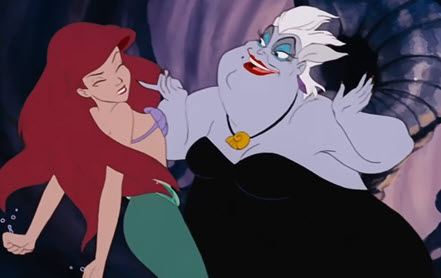
In the enchanting depths of the ocean, where mermaids sing and crustaceans conduct underwater orchestras, Ursula emerges as a force to be reckoned with.
Introduced to audiences in Disney’s “The Little Mermaid” (1989), Ursula is not just a sea witch; she is a character of grandiose malevolence, manipulating the tides of the narrative with her dark and enchanting presence.
Ursula’s introduction is marked by her lair in the dark abyss, surrounded by writhing sea creatures and guarded by her morbidly charismatic eel minions, Flotsam and Jetsam.
With her imposing size, distinct octopus-like features, and a voice that can both soothe and terrify, Ursula becomes an unforgettable antagonist whose every tentacle holds secrets and schemes.
Her Unique Characteristics and Motives
Ursula’s uniqueness lies not only in her appearance but also in her motives. Unlike traditional Disney villains driven by thirst for power or revenge, Ursula is motivated by a desire for control and a twisted sense of justice.
Her infamous deal-making abilities, symbolized by the contract Ariel signs, highlight her cunning nature and the moral ambiguity that defines her character.
Her octopoid design is symbolic of her adaptability and resourcefulness.
Ursula’s ability to transform into a voluptuous human form showcases her manipulative prowess, making her an adversary who doesn’t just rely on brute force but exploits the vulnerabilities of those who dare to strike deals with her.
Impact on Audiences and Cultural Significance
Ursula’s impact extends far beyond the realms of animation. As a character who challenges the traditional expectations of beauty and villainy, she stands out as a symbol of defiance and individuality.
Ursula’s confident and unapologetic demeanour has resonated with audiences, creating a space for more nuanced and diverse portrayals of villains in popular culture.
Her villainous anthem, “Poor Unfortunate Souls,” has become an iconic musical number, celebrated for its theatricality and the dark allure of Ursula’s character.
Moreover, Ursula’s representation as a plus-sized, powerful woman challenges societal norms and contributes to a broader conversation about body positivity and diversity.
Ursula’s cultural significance lies in her ability to be both a formidable antagonist and a character that sparks dialogue about representation and acceptance.
Her legacy endures not only in the underwater realms of Disney’s “The Little Mermaid” but also in the broader cultural landscape, where Ursula remains a symbol of the complexity and power that can be found in characters traditionally labelled as villains.
Scar – The Betraying Brother

In the vast, sun-drenched landscapes of the Pride Lands, Scar prowls as a malevolent force, forever etched into the annals of Disney villainy.
First introduced in Disney’s “The Lion King” (1994), Scar, whose name itself evokes a sinister air, is not just a lion; he is a Shakespearean tragedy, a character whose cunning intellect and dark ambitions set him apart in the realm of animated antagonists.
Scar’s entrance is marked by an air of treachery and betrayal. His dark fur, sunken eyes, and a scar over his left eye all serve as visual cues to his complex personality and the tumultuous history that unfolds in the Pride Lands.
His Cunning and Manipulative Nature
What sets Scar apart is not just his physical prowess but his intellectual cunning. Scar is a master manipulator, using his silver tongue to weave a web of deceit and betrayal.
His calculated schemes to overthrow Mufasa and Simba are executed with a precision that makes him both a tragic and terrifying figure.
Scar’s manipulation of the hyenas, particularly Shenzi, Banzai, and Ed, showcases his ability to exploit the vulnerabilities of those around him.
His insidious charisma draws in his followers, creating a dynamic where loyalty is born out of fear rather than genuine camaraderie.
Scar’s manipulation is not just a means to an end; it becomes a central aspect of his character, highlighting the depth of his malevolence.
Scar’s Role in the Film and His Lasting Impression on Viewers
In “The Lion King,” Scar’s role extends beyond being a mere adversary. As Simba’s uncle and Mufasa’s brother, Scar’s betrayal strikes a deep chord, transforming him into a tragic figure whose motivations are driven by jealousy and a thirst for power.
His machinations lead to the Pride Lands’ descent into chaos, creating a narrative tension that resonates with audiences of all ages.
Scar’s lasting impression on viewers lies in the complexity of his character. He is not a one-dimensional villain; he is a creature of circumstance, shaped by his own insecurities and the weight of his perceived injustices.
His iconic line, “Long live the king,” as he sends Mufasa to his demise, remains etched in the memories of those who have witnessed the emotional turmoil of “The Lion King.”
Scar’s legacy endures not just as a memorable Disney villain but as a character whose tragic flaws and charismatic malevolence have left an indelible mark on the way audiences perceive the blurred lines between hero and villain in animated storytelling.
Cruella de Vil – The Fashionable Fiend
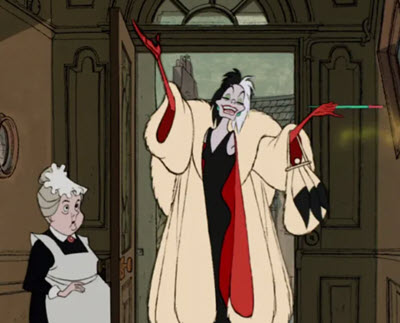
In the glamorous streets of London, where fashion and eccentricity collide, Cruella de Vil emerges as a striking and unforgettable villain in Disney’s “101 Dalmatians” (1961).
A character whose name itself invokes a sense of cruelty, Cruella is not just a woman with a penchant for high fashion; she is a symbol of unbridled greed and heartless pursuit, forever etched in the minds of audiences.
Cruella’s introduction is marked by her distinctive appearance – a skeletal frame draped in extravagant furs, with her half-black, half-white hair creating an image of stark contrast.
Her entrance is accompanied by a swirl of smoke and a devilish laugh, setting the tone for a character whose villainy is as flamboyant as her wardrobe.
Her Distinctive Appearance and Obsession with Fur
Cruella de Vil’s visual design is a testament to Disney’s mastery in character animation. Her elongated cigarette holder, sharp cheekbones, and exaggerated movements create a sense of unease and eccentricity.
However, it is Cruella’s obsession with fur that defines her character and fuels her villainous pursuits.
Draped in opulent furs, Cruella’s desire for a coat made from the spotted pelts of Dalmatian puppies is the driving force of her malevolence.
The stark contrast between her glamorous attire and the innocence of the puppies highlights the depth of her cruelty.
Cruella’s character embodies the dark side of the fashion industry, where vanity and materialism lead to the exploitation of innocent lives.
Cruella’s Impact on Disney’s Portrayal of Villains
Cruella de Vil holds a special place in Disney’s gallery of villains as a character whose evil is intertwined with a peculiar charm and sophistication.
Her impact on Disney’s portrayal of villains lies in the exploration of a different kind of malevolence – one driven by vanity, materialism, and a disregard for the sanctity of life.
Cruella’s flamboyant personality, memorable catchphrases, and unapologetic pursuit of fashion at the expense of morality have set a precedent for future Disney antagonists.
Her legacy extends beyond “101 Dalmatians,” with Cruella becoming a symbol of villainous excess in popular culture.
Her character has been revisited and reimagined, showcasing the enduring fascination audiences have with this fashionable fiend.
In the grand scheme of classic Disney villains, Cruella de Vil stands out as a character who challenges the traditional norms of evil, proving that malevolence can wear a glamorous facade while harbouring a heart as cold as ice.
Hades – The Lord of the Underworld
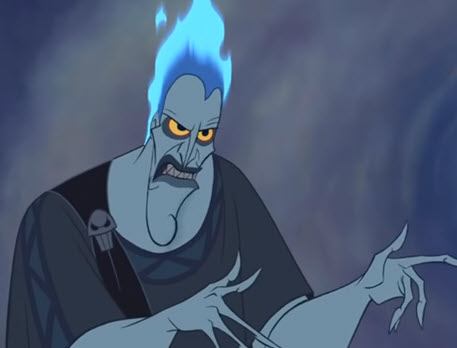
In the mythical realms of ancient Greece, where gods and monsters collide, Hades emerges as a distinctive and dynamic Disney villain in “Hercules” (1997).
As the ruler of the Underworld, Hades is not your typical ominous deity. Instead, he brings a unique blend of humour and menace to the Disney villain pantheon, carving out a space as a character whose charisma and wit set him apart.
Hades’ introduction is marked by his fiery blue hair and a sardonic grin, creating an immediate impression of a character who thrives on mischief and chaos.
Voiced by the charismatic James Woods, Hades becomes a larger-than-life personality, injecting a dose of contemporary humour into the world of Greek mythology.
His Comedic Yet Menacing Personality
Hades’ character is a masterclass in balancing comedy with menace. His quick-witted, sarcastic remarks and contemporary language make him a uniquely relatable and entertaining villain.
Hades is not just a deity with sinister motives; he’s a character whose humour is as potent as his powers.
The juxtaposition of Hades’ comedic persona with his genuine threats to Hercules and the gods creates a multidimensional character.
His ability to switch between charming banter and explosive anger showcases the depth of his character, making him more than just a one-note villain.
Hades’ comedic timing and modern vernacular set him apart, creating a memorable and enjoyable antagonist.
Hades’ Significance in the Disney Villain Pantheon
Hades holds a significant place in the Disney villain pantheon for breaking the mold of traditional malevolence.
Unlike some of his more serious counterparts, Hades provides a breath of fresh air with his humour, making him a character that appeals to a broader audience.
His significance also lies in the way he challenges the expectations of a Disney antagonist. Hades’ character development throughout “Hercules” reveals layers of complexity and vulnerability beneath his confident exterior.
This departure from the typical villain archetype adds depth to his character and contributes to the evolving portrayal of Disney antagonists.
Hades’ enduring popularity has led to his continued presence in Disney’s extended universe, reinforcing his status as a beloved and iconic character.
In the realm of the Underworld, Hades reigns not only as the Lord of the Dead but also as a unique and memorable addition to Disney’s gallery of villains.
Queen of Hearts – The Royal Tyrant

In the whimsical and topsy-turvy world of Wonderland, the Queen of Hearts reigns supreme as a tyrannical force, making her mark as one of Disney’s most iconic villains.
Introduced in “Alice in Wonderland” (1951), the Queen of Hearts commands attention with her oversized presence, both in physical stature and domineering personality.
Her entrance is marked by a storm of chaos and whimsy, fitting for the unpredictable nature of Wonderland.
The Queen of Hearts, with her bulbous head, red heart-shaped dress, and booming voice, becomes an instant symbol of authority and capriciousness.
Her Iconic Catchphrase and Authoritarian Rule
“What do you mean, ‘Off with their heads!'” – this iconic catchphrase, uttered with a mix of fury and delight, encapsulates the essence of the Queen of Hearts.
Her authoritarian rule is characterized by impulsive and severe punishments, most notably her frequent command to behead those who cross her.
The Queen’s whimsical yet terrifying approach to justice creates a surreal and absurd atmosphere in Wonderland.
Her propensity for delivering harsh sentences reflects her volatile and dictatorial nature, making her a memorable embodiment of unchecked power and irrational rule.
The Queen of Hearts’ Unique Role Among Disney Villains
The Queen of Hearts stands out among classic Disney villains for her unique role as a ruler rather than a traditional antagonist.
Her villainy is expressed through her misuse of authority and her tendency to impose extreme punishments at the slightest provocation.
Unlike other villains driven by personal motives, the Queen of Hearts represents a systemic abuse of power, a tyrant ruling over Wonderland with an iron fist.
Her character adds a layer of social commentary to “Alice in Wonderland,” exploring themes of authoritarianism and the absurdity of unchecked rule.
The Queen’s whimsical demeanour and her unpredictable bursts of anger contribute to her complexity as a character, making her both comical and menacing.
In the grand tapestry of Disney villains, the Queen of Hearts reigns as a unique figure, a royal tyrant whose character challenges traditional notions of antagonism.
Through her authoritarian rule and memorable catchphrases, she leaves an indelible mark on Wonderland and the hearts of audiences, showcasing that villainy can take on many forms in the magical worlds crafted by Disney.
Jafar – The Power-Hungry Sorcerer

In the vibrant and mystical city of Agrabah, Jafar emerges as a malevolent force, vying for power and dominance.
First introduced in “Aladdin” (1992), Jafar is not just a royal vizier; he is a power-hungry sorcerer whose cunning and manipulative nature set the stage for a classic tale of good versus evil.
Jafar’s introduction is marked by his dark attire, twisted staff, and a serpent-like sidekick, Iago.
His piercing gaze and ominous presence establish him as a formidable antagonist, laying the groundwork for the machinations that will unfold throughout the narrative.
His Manipulative Tactics and Thirst for Power
Jafar’s character is defined by his insatiable thirst for power and his ability to manipulate those around him to achieve his nefarious goals.
From the outset, his scheming nature is evident as he seeks the magical powers of the Genie and the mystical artefacts that will grant him unparalleled control.
What sets Jafar apart is the subtlety of his manipulation. He operates from the shadows, exploiting the weaknesses and desires of others to further his own agenda.
Whether disguising himself as an aged prisoner or using mind control, Jafar’s manipulative tactics showcase a level of sophistication that elevates him beyond a traditional Disney villain.
Jafar’s Impact on the Narrative and Audience Perception
Jafar’s impact on the narrative of “Aladdin” is profound, shaping the course of events and creating a dynamic clash between his thirst for power and Aladdin’s quest for love and justice.
The tension he introduces adds depth to the storyline, as his cunning plans force the characters to confront their own vulnerabilities.
Furthermore, Jafar’s character has had a lasting impact on audience perception of Disney villains. His strategic mind, combined with a relentless pursuit of power, establishes him as a formidable adversary.
Jafar’s iconic appearance and memorable lines, such as “phenomenal cosmic power, itty-bitty living space,” have permeated popular culture, solidifying his status as one of Disney’s most recognizable and enduring villains.
In the realm of power-hungry sorcerers, Jafar stands tall as a character whose manipulative prowess and insatiable desire for power have left an indelible mark on the narrative and the way audiences perceive the complexities of Disney villains.
Gaston – The Arrogant Hunter
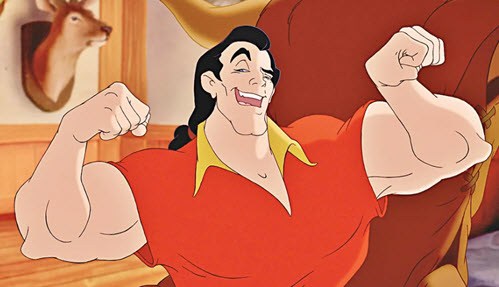
In the provincial town near the enchanted castle, Gaston strides onto the scene as a figure of brawny arrogance and unbridled confidence.
First introduced in “Beauty and the Beast” (1991), Gaston is not just an ordinary hunter; he is a symbol of vanity and entitlement, a foil to the gentle Beast and a classic example of Disney’s exploration of the dangers of superficiality.
Gaston’s entrance is marked by his physical prowess, charm, and a legion of admirers in tow. His square jaw, chiseled physique, and flowing red attire make him an immediate presence, establishing him as the quintessential “hero” in the eyes of the townsfolk.
His Narcissistic Personality and Role as a Foil to the Beast
Gaston’s character is defined by his narcissistic personality, fueled by an unwavering belief in his own superiority. His fixation on outward appearances and societal expectations make him a stark contrast to the Beast, who undergoes a transformative journey of self-discovery.
As a foil to the Beast, Gaston represents the pitfalls of toxic masculinity and unchecked ego. His superficial charm and attempts to win Belle’s affections are driven not by genuine love but by a desire to possess her as a symbol of his conquests.
This dichotomy between Gaston and the Beast serves as a powerful narrative device, illustrating the importance of inner character over external appearances.
Gaston’s Place in Disney’s Gallery of Villains
Gaston holds a unique place in Disney’s gallery of villains as a character whose villainy stems from his human flaws rather than supernatural powers.
While he lacks the magical elements present in some Disney antagonists, Gaston’s charismatic arrogance and relentless pursuit of his own desires make him a memorable and relatable villain.
His impact goes beyond the confines of “Beauty and the Beast,” as Gaston serves as a cautionary tale about the dangers of toxic masculinity and the consequences of prioritizing societal expectations over genuine connection.
His climactic battle with the Beast becomes a symbolic clash between superficiality and true inner beauty, solidifying his place as a classic Disney antagonist.
In the realm of arrogant hunters, Gaston stands out as a character whose flaws mirror those of humanity, showcasing the depth and diversity of Disney’s approach to villainy.
Through Gaston, audiences are reminded that sometimes, the most dangerous villains are those whose darkness lies not in magical spells but in the flaws of the human heart.
Captain Hook – The Pirate Adversary
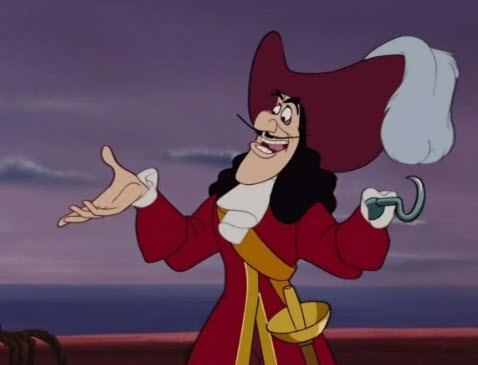
In the timeless realm of Neverland, where dreams and mischief abound, Captain Hook emerges as the archetypal pirate adversary.
First introduced in “Peter Pan” (1953), Captain Hook is not just a swashbuckling antagonist; he is a complex character whose comedic charm and menacing presence make him one of Disney’s most enduring villains.
Captain Hook’s entrance is marked by his flamboyant attire, complete with a feathered hat and an ever-present hook replacing his left hand.
His calculated demeanour and sharp wit establish him as a formidable adversary to the boy who never grows up, Peter Pan.
His Comedic Yet Menacing Portrayal
Captain Hook’s character is a masterful blend of comedy and menace. His exaggerated reactions, bumbling crew, and comedic foibles make him a source of entertainment, particularly in contrast to the mischievous Peter Pan and the whimsical world of Neverland.
However, beneath the surface of his comedic moments lies a character fuelled by vengeance and a deep-seated fear of the crocodile that relentlessly pursues him.
The juxtaposition of Hook’s theatricality and his genuine fears creates a multidimensional character. His comedic traits humanize him, making him more than just a typical Disney villain.
The fear of the crocodile, coupled with Hook’s determination to outsmart Peter Pan, adds layers to his personality and elicits a level of sympathy from the audience.
Captain Hook’s Significance in the Disney Villain Legacy
Captain Hook holds a significant place in the Disney villain legacy as a character whose enduring popularity transcends generations.
His legacy is not only marked by his appearances in various adaptations of “Peter Pan” but also by his influence on the portrayal of pirates in popular culture.
As one of Disney’s earliest villains, Captain Hook set a standard for the portrayal of comedic yet menacing antagonists.
His impact is evident in the way subsequent Disney villains have been crafted with layers of complexity and relatability.
The juxtaposition of Hook’s theatricality and his underlying fears became a template for creating well-rounded and memorable villains in the Disney pantheon.
In the grand scheme of Disney’s pirate adversaries, Captain Hook stands as a character who embodies the spirit of adventure, danger, and the enduring appeal of animated villainy.
Through his legacy, he continues to sail the seas of cinematic history, leaving an indelible mark on the hearts of audiences worldwide.
Evil Queen – The Vain and Wicked Queen

In the enchanted forests where magic and danger intertwine, the Evil Queen stands as a dark and iconic figure.
Introduced in “Snow White and the Seven Dwarfs” (1937), the Evil Queen is not just a wicked stepmother; she is a symbol of vanity, jealousy, and the timeless pursuit of an unattainable standard of beauty.
The Queen’s entrance is marked by her regal yet ominous presence, adorned in a cloak of dark colors that foreshadows the shadows lurking within her heart.
Her imperious gaze and commanding voice immediately establish her as a formidable force in the story.
Her Obsession with Beauty and Transformation
The defining characteristic of the Evil Queen is her insatiable obsession with beauty. Her iconic line, “Magic mirror on the wall, who is the fairest one of all?” unveils her deep-seated insecurity and the lengths to which she is willing to go to maintain her perceived status as the most beautiful in the kingdom.
The Queen’s transformation into an old hag is a manifestation of her internal ugliness and moral decay. This metamorphosis underscores the theme that true beauty lies within, serving as a cautionary tale about the consequences of superficiality and the destructive nature of envy.
The Evil Queen’s Impact on the Disney Villain Archetype
The Evil Queen holds a significant place in the classic Disney villain archetype as the first major antagonist in Disney’s animated feature films. Her character laid the foundation for the portrayal of villains in future Disney classics.
The duality of her beauty and malevolence became a recurring motif, influencing the development of subsequent villainous characters.
The theme of vanity and the consequences of moral corruption explored through the Evil Queen set a precedent for the complexity and depth that could be woven into Disney’s villains.
Her legacy is evident in the way later antagonists grapple with personal flaws and internal struggles, transcending the traditional boundaries of good and evil.
Through the Evil Queen, Disney not only crafted a memorable antagonist for “Snow White and the Seven Dwarfs” but also established a template for villains whose motivations and downfalls are rooted in human flaws.
The impact of the Evil Queen on the Disney villain archetype endures, as subsequent generations continue to be captivated by the timeless allure of animated malevolence.
Conclusion
In the magical realms of Disney’s storytelling, we’ve embarked on a journey through the shadows and darkness, exploring the 10 classic Disney villains that have left an indelible mark on the tapestry of animated classics.
Each of these villains has brought their own brand of malevolence, complexity, and enduring charm to the Disney universe, captivating audiences across generations.
The Enduring Appeal and Impact of These Villains
What makes these villains timeless and unforgettable is more than their nefarious deeds; it’s the depth and complexity woven into their characters.
From the tragic fall of Scar to the whimsical tyranny of the Queen of Hearts, each villain has become a symbol of the rich storytelling that defines Disney.
These villains transcend their roles as mere foils for heroes; they are archetypes of the human condition, embodying universal themes of power, vanity, and the struggle between good and evil.
Their impact is not limited to the confines of their respective films; their influence reverberates throughout popular culture, shaping the way we perceive animated antagonists.
Share Your Favorite Disney Villains and Memories
As we celebrate the legacy of these iconic villains, we encourage you, our dear readers, to reflect on YOUR favourite Disney villains and the memories they’ve created.
Whether it’s the first time Maleficent’s horns pierced the darkness or the unforgettable antics of Captain Hook and his crocodile nemesis, classic Disney villains have a unique way of etching themselves into our hearts.
Share your Favorite Disney villain memories, discuss the characters that left a lasting impact on you, and revel in the enchantment of these timeless tales.
For in the realm of Disney, where heroes and villains dance in the moonlit glow of imagination, the stories continue to unfold, leaving behind a legacy of magic, mischief, and the enduring allure of animated villainy.
